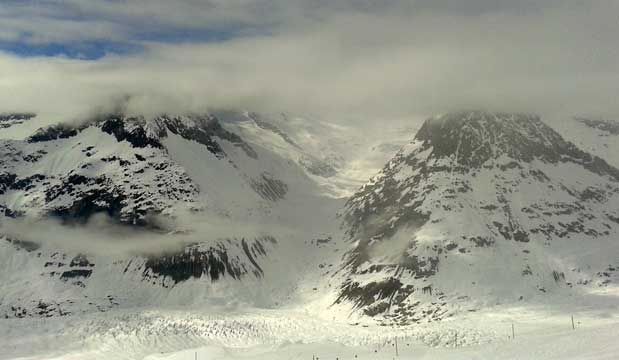By Christian Siderius, Alterra
HI-AWARE was presented in Riederalp, Switzerland, at a special five-day workshop, 24-28 March 2015, dedicated to climate extremes and policy. About 40 experts in the field of climate extremes had gathered, mostly from Europe, but there were also contributions from Canada, South America and South Asia. Presentations covered the globe. The workshop was divided into five sessions, each with a specific theme:
- SESSION 1: HEAT/COLD WAVES AND RELATED IMPACTS
- SESSION 2: HEAVY PRECIPITATION, DROUGHT AND HYDROLOGICAL RESPONSES
- SESSION 3: WIND STORMS AND RELATED EVENTS
- SESSION 4: METHODOLOGIES FOR STUDYING EXTREMES (STATISTICAL METHODS, ETC.)
- SESSION 5: LINKS TO POLICY
In the evening sessions, the state of the art and future research directions, as well as the contribution to or interaction with policy, were discussed.
HI-AWARE was presented in session 2 in a slot with several other projects on South Asia. The discussions focused not only on the project goal and setup, but also on the first results of the irrigation, hydrologic and hydro-economic modelling and the way we deal with extremes in the projects. The idea of critical moments was introduced. It was highlighted that we aim to look at not only extremes in the meteorological data itself, but also at the possibilities that there could be extreme impacts by a combination of events that in themselves are not that extreme; e.g. a combination of a late monsoon and early heat waves together with a shift in glacier and snowmelt. Questions and comments from the room related, amongst others, to how we would like to derive such detailed shifts from climate scenarios based on global circulation models (GCMs) and how we would like to use these scenarios in hydrological modelling.
 Aletsch glacier, Riederalp, Switzerland
Aletsch glacier, Riederalp, Switzerland
Two other South-Asia relevant presentations focused on the Kedarnath floods of 2013, one by Dr Manohar Arora of the National Institute of Hydrology, Roorkee, India, and the other by Dr Simon Allen of the Universities of Geneva and Zurich, Switzerland. Both presenters work for the Swiss-funded IH-CAP project, which focuses on capacity building in India. While Dr Arora gave a general overview and compared Kedarnath’s with Gangotri’s measurements, Dr Allen showed in more detail the different processes that contributed to the disaster and highlighted, amongst others, that snow cover was actually lower than average just before the event, not higher as sometimes claimed, and that it was mainly the rainfall response on the exposed lake catchment that had triggered the disaster.
In a keynote session, Paul Whitehead, of the University of Oxford, United Kingdom, introduced a semi-distributed flow and water quality model (INCA) that has been set up for the whole of the Ganges and Brahmaputra River systems from the high Himalayas, through the middle hills, down to the plains of India and Bangladesh. The INCA model simulates daily flows, sediments and nutrients (nitrogen, ammonia, total and soluble phosphorus) and has been applied as part of the ESPA Deltas project (see www.espadelta.net). We discussed, informally, that there might be interesting compatibility between the work done in HI-AWARE and his work in the ESPA project. Several of the ESPA project partners (e.g. Southampton) are also involved in DECCMA.
Another presentation of interest was the one from Ricardo Garcia Herrera, of the Universidad Complutense Madrid, Spain, who showed that historical documentary sources are a valuable tool for analysing climate variability from a long-term perspective. Using wind directions and speeds as recorded by merchant vessels over the centuries, the university’s researchers are now trying to get longer time-series of the onset of the monsoon, including data for South Asia.
As usual, there was much focus on the robustness of results and to what extent extremes can actually be attributed to climate change and how to present this to policy makers and the public. There seems to be some challenges in matching, on the one hand, quite severe expected changes, and on the other, a large variability between models and within models, making it often difficult to distinguish cc from natural variability with certainty. So while return periods of extreme events (heat/drought/high-intensity) are expected to decrease by an order of 5 to 10 in several cases, becoming much more frequent, at the same time most scientists are still careful (too careful?) to put too much emphasis on them. It was, however, recognised that the climate change discourse will be an important driver of adaptation, whatever the real cause of these extreme events. Scientists could possibly adapt with a sort of scale-indicator, showing how certain the contribution of climate change could be to an extreme event based on several indices, which would be better than any ‘yes or no’ answer.
Finally, it was felt that the ‘Loss and Damage’ discussion would create some additional challenges because science is not yet ready for the specific attribution of climate change effects.
